Blog
Why Do I Have Plantar Fasciitis?
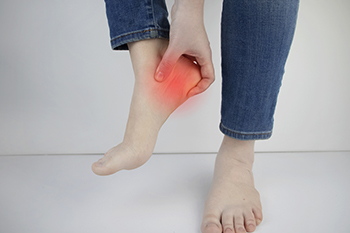
The plantar fascia is found on the sole of the foot. It is the band of tissue that connects the toes to the heel, and it is instrumental in pointing and flexing the foot. An injury or overuse can cause this tissue to become torn or irritated, which may lead to getting plantar fasciitis. Patients who are afflicted with this condition often have difficulty in walking, and will seek the advice of a medical professional for relief. The pain is felt in the heel which can cause severe discomfort. Runners may be prone to developing plantar fasciitis as a result of the repeated force the heels endure as well. It can also develop from wearing shoes that do not fit correctly, or that have minimum cushion support. Effective stretches can help the foot feel better. These can include the calf stretch which is done by standing on a step while lowering one heel at a time until a gentle stretch is felt. If you have heel pain, it is strongly suggested that you contact a podiatrist who can effectively diagnose and treat plantar fasciitis.
Plantar fasciitis is a common foot condition that is often caused by a strain injury. If you are experiencing heel pain or symptoms of plantar fasciitis, contact Dr. Kendall Blackwell from InStride Wilson Podiatry Associates. Our doctor can provide the care you need to keep you pain-free and on your feet.
What Is Plantar Fasciitis?
Plantar fasciitis is one of the most common causes of heel pain. The plantar fascia is a ligament that connects your heel to the front of your foot. When this ligament becomes inflamed, plantar fasciitis is the result. If you have plantar fasciitis you will have a stabbing pain that usually occurs with your first steps in the morning. As the day progresses and you walk around more, this pain will start to disappear, but it will return after long periods of standing or sitting.
What Causes Plantar Fasciitis?
- Excessive running
- Having high arches in your feet
- Other foot issues such as flat feet
- Pregnancy (due to the sudden weight gain)
- Being on your feet very often
There are some risk factors that may make you more likely to develop plantar fasciitis compared to others. The condition most commonly affects adults between the ages of 40 and 60. It also tends to affect people who are obese because the extra pounds result in extra stress being placed on the plantar fascia.
Prevention
- Take good care of your feet – Wear shoes that have good arch support and heel cushioning.
- Maintain a healthy weight
- If you are a runner, alternate running with other sports that won’t cause heel pain
There are a variety of treatment options available for plantar fasciitis along with the pain that accompanies it. Additionally, physical therapy is a very important component in the treatment process. It is important that you meet with your podiatrist to determine which treatment option is best for you.
If you have any questions, please feel free to contact our office located in Wilson, NC . We offer the newest diagnostic and treatment technologies for all your foot care needs.
What Is the Ball of the Foot?

Learning about the biomechanics of the feet can be useful for anyone concerned with maintaining the health of their feet. For instance, the ball of the foot is a critical part of the foot that serves many important functions. The ball of the foot is located near the front of the foot just underneath the toes. This area of the foot can be susceptible to pain for many different reasons. Specifically, pain in the ball of the feet may be caused by stress fractures, being overweight, or from wearing high heels. If nothing is done to address pain that is felt in the ball of the feet, it is possible that this might ultimately alter one’s natural gait. Upon seeking medical attention, you might be instructed by a podiatrist to do any number of different things to treat the pain. Your podiatrist might recommend that you rest or wear better-fitting shoes for instance. If you are someone that is experiencing pain in the ball of your feet, it is suggested that you schedule an appointment with a podiatrist today.
If you have any concerns about your feet, contact Dr. Kendall Blackwell from InStride Wilson Podiatry Associates. Our doctor can provide the care you need to keep you pain-free and on your feet.
Biomechanics in Podiatry
Podiatric biomechanics is a particular sector of specialty podiatry with licensed practitioners who are trained to diagnose and treat conditions affecting the foot, ankle and lower leg. Biomechanics deals with the forces that act against the body, causing an interference with the biological structures. It focuses on the movement of the ankle, the foot and the forces that interact with them.
A History of Biomechanics
- Biomechanics dates back to the BC era in Egypt where evidence of professional foot care has been recorded.
- In 1974, biomechanics gained a higher profile from the studies of Merton Root, who claimed that by changing or controlling the forces between the ankle and the foot, corrections or conditions could be implemented to gain strength and coordination in the area.
Modern technological improvements are based on past theories and therapeutic processes that provide a better understanding of podiatric concepts for biomechanics. Computers can provide accurate information about the forces and patterns of the feet and lower legs.
Understanding biomechanics of the feet can help improve and eliminate pain, stopping further stress to the foot.
If you have any questions please feel free to contact our office located in Wilson, NC . We offer the newest diagnostic and treatment technologies for all your foot and ankle needs.
Do Your Child's Feet Hurt?
What Can Wearing High Heels Do to My Feet?

Various benefits can come from wearing high heels. High heels can make the legs look slender and make you appear taller. Despite these attractions, there are also risks associated with frequently wearing high heels, including ankle instability, and the heel may undergo extreme pressure. The foot structure may change when high heels are worn often, and bunions and hammertoes could develop or worsen. Additionally, corns can form on the side of the pinky toe or top of the toes due to limited room in the toe area. Heel pain may indicate that plantar fasciitis or Achilles tendonitis has developed, possibly causing difficulty pointing and flexing the toes. Foot pain may be prevented when wearing shoes with a lower heel, and shoes that have a wedge may provide extra support. If you would like more information about the pros and cons of wearing high heels it is suggested that you consult with a podiatrist.
High heels have a history of causing foot and ankle problems. If you have any concerns about your feet or ankles, contact Dr. Kendall Blackwell from InStride Wilson Podiatry Associates. Our doctor can provide the care you need to keep you pain-free and on your feet.
Effects of High Heels on the Feet
High heels are popular shoes among women because of their many styles and societal appeal. Despite this, high heels can still cause many health problems if worn too frequently.
Which Parts of My Body Will Be Affected by High Heels?
- Ankle Joints
- Achilles Tendon – May shorten and stiffen with prolonged wear
- Balls of the Feet
- Knees – Heels cause the knees to bend constantly, creating stress on them
- Back – They decrease the spine’s ability to absorb shock, which may lead to back pain. The vertebrae of the lower back may compress.
What Kinds of Foot Problems Can Develop from Wearing High Heels?
- Corns
- Calluses
- Hammertoe
- Bunions
- Morton’s Neuroma
- Plantar Fasciitis
How Can I Still Wear High Heels and Maintain Foot Health?
If you want to wear high heeled shoes, make sure that you are not wearing them every day, as this will help prevent long term physical problems. Try wearing thicker heels as opposed to stilettos to distribute weight more evenly across the feet. Always make sure you are wearing the proper shoes for the right occasion, such as sneakers for exercising. If you walk to work, try carrying your heels with you and changing into them once you arrive at work. Adding inserts to your heels can help cushion your feet and absorb shock. Full foot inserts or metatarsal pads are available.
If you have any questions please feel free to contact our office located in Wilson, NC . We offer the newest diagnostic and treatment technologies for all your foot and ankle needs.
Foot Pain and Corns
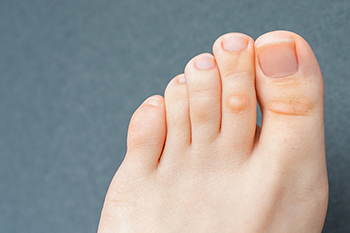
Corns on the feet are a condition that is similar yet distinct from blisters. Essentially, corns are hardened layers of skin that can form in response to friction or pressure on the feet. Many patients often ask podiatrists to what extent pain can be felt from corns. The answer is complicated, because typically, many people do not feel pain in the beginning stages of developing a corn. However, if a corn becomes more severe as time passes, it may become uncomfortable. When the corn becomes irritated, it often increases the level of pain. In these situations, treatment can be sought to remedy the corn which may bring mild relief. If you are someone that is currently suffering from corns on the feet, it is suggested that you contact a podiatrist today for more information.
Foot Pain
Foot pain can be extremely painful and debilitating. If you have a foot pain, consult with Dr. Kendall Blackwell from InStride Wilson Podiatry Associates. Our doctor will assess your condition and provide you with quality foot and ankle treatment.
Causes
Foot pain is a very broad condition that could be caused by one or more ailments. The most common include:
- Bunions
- Hammertoes
- Plantar Fasciitis
- Bone Spurs
- Corns
- Tarsal Tunnel Syndrome
- Ingrown Toenails
- Arthritis (such as Gout, Rheumatoid, and Osteoarthritis)
- Flat Feet
- Injury (from stress fractures, broken toe, foot, ankle, Achilles tendon ruptures, and sprains)
- And more
Diagnosis
To figure out the cause of foot pain, podiatrists utilize several different methods. This can range from simple visual inspections and sensation tests to X-rays and MRI scans. Prior medical history, family medical history, and any recent physical traumatic events will all be taken into consideration for a proper diagnosis.
Treatment
Treatment depends upon the cause of the foot pain. Whether it is resting, staying off the foot, or having surgery; podiatrists have a number of treatment options available for foot pain.
If you have any questions, please feel free to contact our office located in Wilson, NC . We offer the newest diagnostic and treatment technologies for all your foot care needs.
How Common Is Increased Foot Size During Pregnancy?

When an individual is pregnant, they might notice that the size of their feet has significantly increased. This is due to the fact that the hormone known as relaxin is released during pregnancy, which can cause the feet to expand and get larger. New mothers often ask how common it is for a woman’s feet to increase during pregnancy. The answer is that 60% of women have seen their feet get longer, and 70% of women have seen their feet get wider. Therefore, it is a relatively common phenomenon. Increasing foot size is just one of many different potential changes that your body might go through during pregnancy. If you are pregnant or planning to be, it is suggested that you contact a podiatrist today for an appointment.
Pregnant women with swollen feet can be treated with a variety of different methods that are readily available. For more information about other cures for swollen feet during pregnancy, consult with Dr. Kendall Blackwell from InStride Wilson Podiatry Associates. Our doctor will attend to all of your foot and ankle needs.
What Foot Problems Can Arise During Pregnancy?
One problem that can occur is overpronation, which occurs when the arch of the foot flattens and tends to roll inward. This can cause pain and discomfort in your heels while you’re walking or even just standing up, trying to support your baby.
Another problem is edema, or swelling in the extremities. This often affects the feet during pregnancy but tends to occur in the later stages.
How Can I Keep My Feet Healthy During Pregnancy?
- Wearing orthotics can provide extra support for the feet and help distribute weight evenly
- Minimize the amount of time spent walking barefoot
- Wear shoes with good arch support
- Wear shoes that allow for good circulation to the feet
- Elevate feet if you experience swelling
- Massage your feet
- Get regular, light exercise, such as walking, to promote blood circulation to the feet
If you have any questions please feel free to contact our office located in Wilson, NC . We offer the newest diagnostic and treatment technologies for all your foot and ankle needs.
Tips for Working on Your Feet
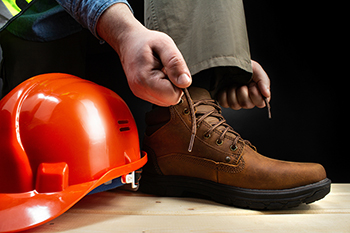
Sitting at a desk all day long, with little time for movement, or spending prolonged time working on your feet, both have challenges. Paramedics, nurses, teachers, wait staff, and retail workers are some examples of those who spend a significant amount of time standing or walking while working. There are things one can do to minimize the detrimental effects of working on the feet. Simple things include investing in comfortable, supportive, and well-fitting footwear, getting feet massaged, and soaking one’s feet after a long day. One can also stretch the feet and legs if they must spend significant time on their feet while working. Calf raises and standing on one’s toes and balancing are things that can be done within minutes while at work and without raising awareness or requiring extra space or equipment. Elevating the feet when given a chance is helpful too. As people who have sedentary types of jobs need to make time to move more, and those who spend most of their workday on their feet need to make time for relaxation. If you have foot pain from having a job that requires you to be on your feet for an extended time, consider seeing a podiatrist for more helpful tips to increase your comfort and prevent chronic foot issues.
While working on the feet, it is important to take the proper care of them. For more information about working on your feet, contact Dr. Kendall Blackwell from InStride Wilson Podiatry Associates. Our doctor will treat your foot and ankle needs.
Working on Your Feet
Standing on your feet for long periods of time can cause stress and pain in your feet. Your whole body may experience change in terms of posture, back pain, bunions, callouses and or plantar warts. There are ways to avoid these conditions with proper foot care, smart choices and correct posture.
Positive Changes
Negative heeled shoe – Choosing this shoe type places the heel slightly lower than the ball of the foot. These are great for overall foot health. Find shoes that fit you correctly.
Go barefoot – Our feet were not designed to be enclosed for all hours of the day. Try to periodically expose your feet to air.
Eliminate Pain
Foot Exercises – Performing simple exercises, incorporating yoga and doing stretches are beneficial. This will allow increased blood flow to the area and muscles of the foot.
Achilles tendon – Stretching the foot out flat on the floor will relax the calf muscles and tendon. These exercises can be performed almost anywhere. Make sure you add these exercises to your daily regimen.
With a little bit of this information and knowing more about foot health, you will notice changes. Foot stretches and proper footwear will help with pain and prevent further issues.
If you have any questions please feel free to contact our office located in Wilson, NC . We offer the newest diagnostic and treatment technologies for all your foot and ankle needs.
Plantar Warts Can Be Treated!
Arthritis in the Toes
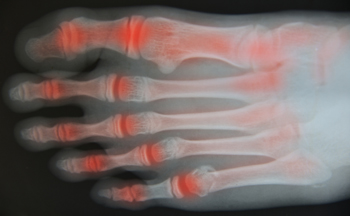
Arthritis can occur in any part of the body where joints exist. Since toes have many joints, this is a common place for arthritis to develop. Different types of arthritis can attack the toes, primarily osteoarthritis, rheumatoid arthritis, and gout. If the cartilage wears away between the bones in the toes, they will rub together and inflammation will occur. The big toe is the one most often affected. Past injuries, such as broken or sprained toes, can gradually cause arthritis. Aging, being overweight, and having a family history of arthritis are risk factors for this affliction. Symptoms of toe arthritis include pain, stiffness, and swelling. A clicking, popping, or a grinding noise can also be symptoms. Toe arthritis can cause difficulty with mobility. If you have toe pain, it is suggested that you consult with a podiatrist who can properly diagnose arthritis, and provide correct treatment options.
Arthritis can be a difficult condition to live with. If you are seeking treatment, contact Dr. Kendall Blackwell from InStride Wilson Podiatry Associates. Our doctor can provide the care you need to keep you pain-free and on your feet.
Arthritic Foot Care
Arthritis is a joint disorder that involves the inflammation of different joints in your body, such as those in your feet. Arthritis is often caused by a degenerative joint disease and causes mild to severe pain in all affected areas. In addition to this, swelling and stiffness in the affected joints can also be a common symptom of arthritis.
In many cases, wearing ill-fitting shoes can worsen the effects and pain of arthritis. Wearing shoes that have a lower heel and extra room can help your feet feel more comfortable. In cases of rheumatoid arthritis, the arch in your foot may become problematic. Buying shoes with proper arch support that contour to your feet can help immensely.
Alleviating Arthritic Pain
- Exercises that stretch the foot can prevent further pain and injury and increase mobility
- Most of the pain can be alleviated with anti-inflammatory drugs, heat, and topical medications
- Massages can help temporarily alleviate pain.
It is best to see your doctor for the treatment that is right for your needs and symptoms. Conditions vary, and a podiatrist can help you determine the right method of care for your feet.
If you have any questions, please feel free to contact our office located in Wilson, NC . We offer the newest diagnostic tools and technology to treat your foot and ankle needs.
Prolonged Standing and Cracked Heels
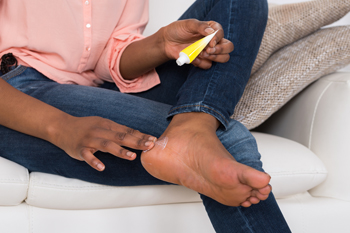
Cracked heels can occur when the skin on the back of the heels becomes excessively dry, due to a lack of moisture. These cracks may deepen and collect debris, which are known as fissures. Many different things can contribute to the development of cracked heels. Standing for prolonged periods of time, for example, can lead to the onset of cracked heels. Particularly, if an individual is standing on hard surfaces, such as concrete or uneven terrain, this may also be a reason this ailment may develop. If you are someone who must stand for hours at a time, then wearing supportive footwear that is padded may improve your situation. It is suggested that you schedule an appointment with a podiatrist today if you are concerned about getting cracked heels from standing.
Cracked heels are unsightly and can cause further damage to your shoes and feet. If you have any concerns, contact Dr. Kendall Blackwell from InStride Wilson Podiatry Associates. Our doctor can provide the care you need to keep you pain-free and on your feet.
Cracked Heels
Cracked heels appear unappealing and can make it harder for you walk around in sandals. Aside from looking unpleasant, cracked heels can also tear stockings, socks, and wear out your shoes. There are several methods to help restore a cracked heel and prevent further damage.
How Do You Get Them?
Dry skin is the number one culprit in creating cracked heels. Many athletes, walkers, joggers, and even swimmers suffer from cracked heels. Age and skin oil production play a role to getting cracked heels as well.
Promote Healing
Over the counter medicines can help, especially for those that need instant relief or who suffer from chronic dry feet.
Wear Socks – Wearing socks with medicated creams helps lock in moisture.
Moisturizers – Applying both day and night will help alleviate dryness which causes cracking.
Pumice Stones – These exfoliate and remove dead skin, which allows for smoother moisturizer application and better absorption into the skin.
Change in Diet
Eating healthy with a well-balanced diet will give the skin a fresh and radiant look. Your body responds to the kinds of food you ingest. Omega-3 fatty acids and zinc supplements can also revitalize skin tissue.
Most importantly, seek professional help if unsure how to proceed in treating cracked heels. A podiatrist will help you with any questions or information needed.
If you have any questions, please feel free to contact our office located in Wilson, NC . We offer the newest diagnostic and treatment technologies for all your foot care needs.
More...
Dealing With Peroneal Tendonitis
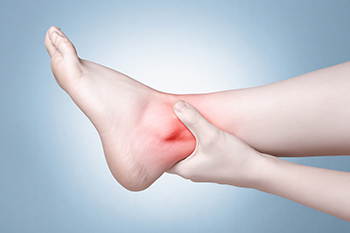
Peroneal tendonitis is inflammation of the tendons that connect your leg to your foot. These tendons run along the outside of the ankle bone and foot. Peroneal tendonitis is an overuse injury, but it can also be caused by a fall or other trauma to your foot. Symptoms include pain along the outside of the foot and ankle that increases with activity. Swelling, redness, and warmth may also develop. Peroneal tendonitis generally starts with tears in the tissue, but if ignored can develop into a rupture. Because this injury exhibits traits commonly attributed to other ankle pain, it can be difficult to diagnose. A visit to a podiatrist is suggested, where the foot doctor can perform a series of tests to determine the cause. Treatment, which may take a month or more, includes taking non-steroidal anti-inflammatory medication, wearing a protective brace or soft cast, and performing certain exercises. In severe cases, surgery to clean out the damaged tissue is required. For more information, it is suggested that you make an appointment with a podiatrist.
Ankle pain can be caused by a number of problems and may be potentially serious. If you have ankle pain, consult with Dr. Kendall Blackwell from InStride Wilson Podiatry Associates. Our doctor will assess your condition and provide you with quality foot and ankle treatment.
Ankle pain is any condition that causes pain in the ankle. Due to the fact that the ankle consists of tendons, muscles, bones, and ligaments, ankle pain can come from a number of different conditions.
Causes
The most common causes of ankle pain include:
- Types of arthritis (rheumatoid, osteoarthritis, and gout)
- Ankle sprains
- Broken ankles
- Achilles tendonitis
- Achilles tendon rupture
- Stress fractures
- Bursitis
- Tarsal tunnel syndrome
- Plantar fasciitis
Symptoms
Symptoms of ankle injury vary based upon the condition. Pain may include general pain and discomfort, swelling, aching, redness, bruising, burning or stabbing sensations, and/or loss of sensation.
Diagnosis
Due to the wide variety of potential causes of ankle pain, podiatrists will utilize a number of different methods to properly diagnose ankle pain. This can include asking for personal and family medical histories and of any recent injuries. Further diagnosis may include sensation tests, a physical examination, and potentially x-rays or other imaging tests.
Treatment
Just as the range of causes varies widely, so do treatments. Some more common treatments are rest, ice packs, keeping pressure off the foot, orthotics and braces, medication for inflammation and pain, and surgery.
If you have any questions, please feel free to contact our office located in Wilson, NC . We offer the newest diagnostic and treatment technologies for all your foot care needs.
Simple Techniques for Everyday Foot Care
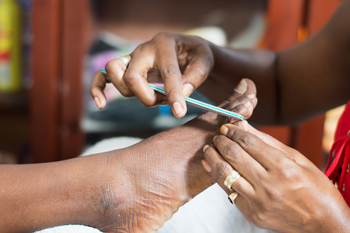
The result of practicing a good everyday foot care routine can improve the skin on the feet, in addition to possibly providing a general sense of well being. The feet endure the weight of the body, and they are often the most neglected area when engaging in self-care. Cold winter months may cause the skin on the feet to flake or crack, and using a good moisturizer may restore the oils in the skin. The skin can soften when they are soaked in warm water with Epsom salt, and the feet can be exfoliated as they are rubbed together. It is beneficial to trim the toenails to the desired length, and this can prep the nails to be polished. The feet can feel better when the correct size shoes and socks are worn and gentle toe stretches are performed. If you have questions and would like to learn about additional everyday foot care techniques, it is suggested that you confer with a podiatrist.
Everyday foot care is very important to prevent infection and other foot ailments. If you need your feet checked, contact Dr. Kendall Blackwell from InStride Wilson Podiatry Associates. Our doctor can provide the care you need to keep you pain-free and on your feet.
Everyday Foot Care
Often, people take care of their bodies, face and hair more so than they do for their feet. But the feet are a very important aspect of our bodies, and one that we should pay more attention to. Without our feet, we would not be able to perform most daily tasks.
It is best to check your feet regularly to make sure there are no new bruises or cuts that you may not have noticed before. For dry feet, moisturizer can easily be a remedy and can be applied as often as necessary to the affected areas. Wearing shoes that fit well can also help you maintain good foot health, as well as making it easier to walk and do daily activities without the stress or pain of ill-fitting shoes, high heels, or even flip flops. Wearing clean socks with closed shoes is important to ensure that sweat and bacteria do not accumulate within the shoe. Clean socks help to prevent Athlete’s foot, fungi problems, bad odors, and can absorb sweat.
If you have any questions please feel free to contact our office located in Wilson, NC . We offer the newest diagnostic and treatment technologies for all your foot and ankle needs.
Pre-Podiatry Concentrations

Podiatrists are medical professionals that specialize in maintaining the health of patient’s feet. They are trained in treating a wide range of different foot conditions. Some podiatrists can begin gaining their skills at their undergraduate institution through a pre-podiatry concentration. In these programs, an individual can prepare to be admitted into a Doctor of Podiatric Medicine (DPM) degree program. Through this kind of concentration, an individual can learn more about biology and the sciences while conducting independent research projects. This is just one potential step along a podiatrist’s long journey to becoming a professional podiatrist. If you are someone that is struggling with the health of your feet, it is suggested that you seek out a podiatrist.
If you are experiencing pain in the feet or ankles, don’t join the stubborn majority refusing treatment. Feel free to contact Dr. Kendall Blackwell from InStride Wilson Podiatry Associates. Our doctor can provide the care you need to keep you pain-free and on your feet.
What Is a Podiatrist?
Someone would seek the care of a podiatrist if they have suffered a foot injury or have common foot ailments such as heal spurs, bunions, arch problems, deformities, ingrown toenails, corns, foot and ankle problems, etc.
Podiatric Treatment
A podiatrist will treat the problematic areas of the feet, ankle or lower leg by prescribing the following:
- Physical therapy
- Drugs
- Orthotic inserts or soles
- Surgery on lower extremity fractures
A common podiatric procedure a podiatrist will use is a scanner or force plate which will allow the podiatrist to know the designs of orthotics. Patients are then told to follow a series of tasks to complete the treatment. The computer will scan the foot a see which areas show weight distribution and pressure points. The podiatrist will read the analysis and then determine which treatment plans are available.
If you have any questions please feel free to contact our office located in Wilson, NC . We offer the newest diagnostic and treatment technologies for all your foot and ankle needs.



